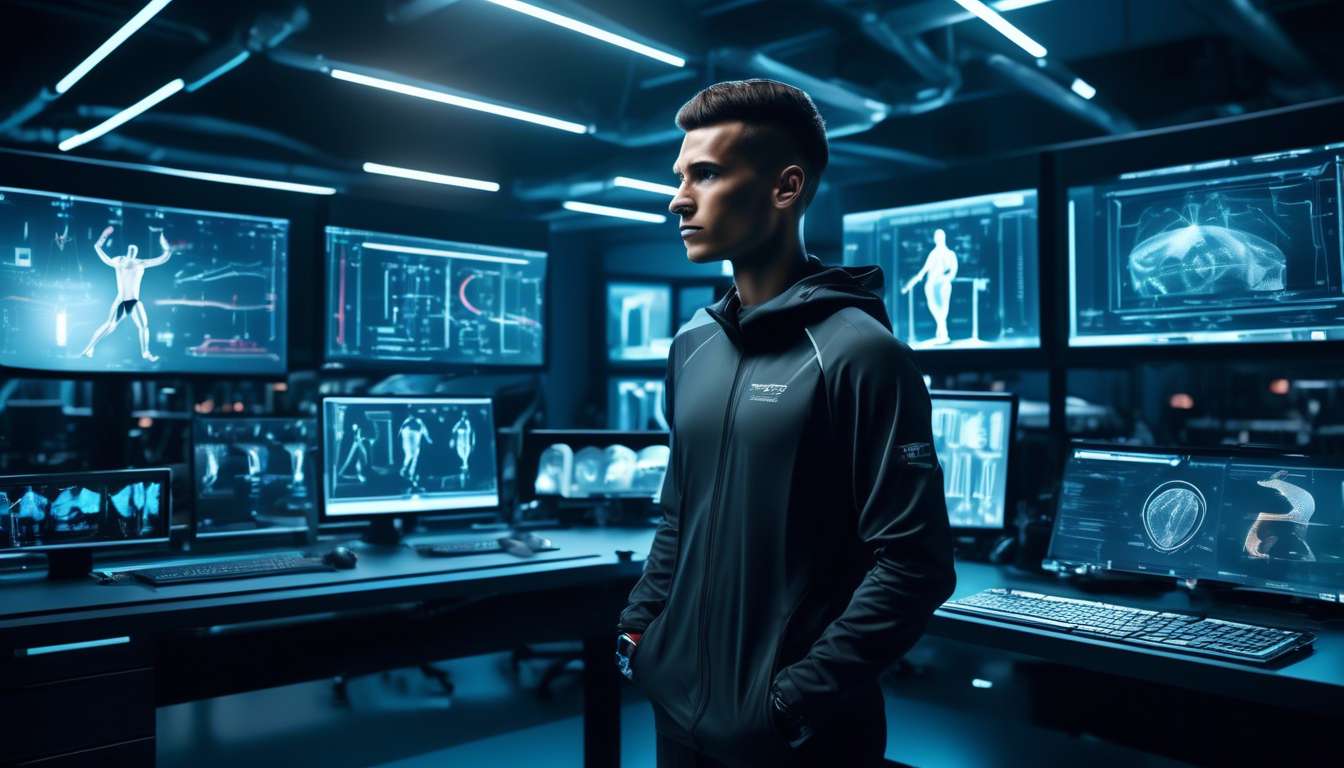As sports enthusiasts and researchers, we often find ourselves immersed in the dynamic world of athletic performance, where data and analysis play a crucial role in understanding and enhancing the games we love.
In our quest to uncover the nuances that define success on the field, essential sports research methodologies become our guiding tools. Together, we navigate through a landscape that demands:
- Rigor
- Precision
- Innovation
Our aim is to connect statistical insights with real-world applications.
Our journey involves a collaborative effort to explore a wide array of methods:
-
Quantitative Analyses: These methods quantify performance metrics, offering measurable insights into athletic performance.
-
Qualitative Approaches: These delve into the psychological aspects of athletes, providing a deeper understanding of mental and emotional factors.
By integrating these methodologies, we aim to provide a comprehensive understanding that not only advances the sports industry but also enriches the experiences of athletes, coaches, and fans alike.
In this article, we embark on a journey to explore these essential methodologies, laying the groundwork for future breakthroughs in sports research.
Data Collection Techniques
In sports research, we employ various data collection techniques to gather accurate and reliable information. By doing so, we ensure our findings contribute meaningfully to the community seeking to enhance athletic performance. Whether we’re tracking an athlete’s progress or evaluating a new training method, our approach is rooted in meticulous experimental design. This foundation allows us to systematically test hypotheses and explore the relationships between different performance metrics.
As a collaborative team, we embrace diverse methodologies, including:
- Observational studies
- Controlled experiments
These techniques empower us to capture a wide range of data, which is pivotal for comprehensive data analysis. By weaving together quantitative and qualitative insights, we gain a holistic understanding of sports dynamics.
Our shared goal is to create a supportive environment where everyone feels their efforts are part of something bigger. Together, we transform raw data into actionable knowledge, helping athletes and coaches make informed decisions that elevate performance and foster a sense of belonging in the sporting world.
Performance Analysis Tools
To accurately assess and enhance athletic performance, we rely on a suite of advanced performance analysis tools that transform data into actionable insights. These tools enable us to dive deep into performance metrics, offering a comprehensive understanding of an athlete’s strengths and areas for improvement. By embracing these tools, we foster a community where every member feels supported and empowered to reach their full potential.
Our experimental design approach allows us to tailor these tools specifically to the needs of our athletes, ensuring that the data we gather is both relevant and precise.
Key components include:
- Tracking progress over time with performance metrics
- Providing a sense of belonging and shared goals among team members
By leveraging data analysis, we create strategies that optimize performance outcomes and build a collective sense of achievement.
As we share these insights, our community becomes more connected, united by a common purpose: excellence in athletic performance.
Survey and Interview Methods
We utilize a combination of surveys and interviews to gather valuable qualitative insights into athletes’ experiences and perceptions. These tools help us create a sense of community by inviting athletes to share their stories, ensuring their voices are heard and valued.
Through carefully crafted questions, we explore:
- Motivation
- Challenges
- Triumphs
This approach provides a rich tapestry of data that informs our research.
Our approach to data analysis focuses on identifying patterns and trends that reflect athletes’ needs and aspirations. This allows us to refine performance metrics. By integrating these qualitative insights with quantitative data, we develop a holistic understanding of athletic performance. This synthesis is crucial in designing experiments that are both effective and relevant.
In our experimental design, we prioritize athletes’ perspectives, ensuring their input shapes the direction and focus of our investigations. By doing so, we not only enhance the validity of our research but also foster a collaborative environment where athletes feel they truly belong.
Biomechanical Assessments
Biomechanical assessments allow us to precisely measure and analyze the physical movements of athletes, offering insights essential for enhancing performance and preventing injuries.
By immersing ourselves in data analysis, we can extract meaningful performance metrics that guide athletes toward their personal best. Together, we can create a supportive community that values the meticulous process of experimental design, ensuring our methods are reliable and results are impactful.
In our assessments, we utilize cutting-edge technology to capture every detail of an athlete’s movement, such as:
- The arc of a swing
- The bend of a knee
This data becomes our ally, helping us identify inefficiencies and potential injury risks.
By refining performance metrics, we empower athletes to make informed adjustments, fostering a sense of belonging within our community of like-minded individuals striving for excellence.
As we collaborate, our shared knowledge elevates both individual and team performance, uniting us in our collective pursuit of sporting success.
Observational Research Strategies
In our observational research strategies, we meticulously watch and document athletes’ behaviors in their natural settings to uncover insights that structured experiments might miss. By embedding ourselves in these environments, we gain a deeper understanding of the context in which athletes perform.
This approach allows us to collect rich data, which is essential for thorough data analysis and refining our performance metrics.
We don’t just observe passively; instead, we engage actively with the process. Our role is to capture genuine moments that might influence performance outcomes.
Through careful documentation, we identify patterns and trends that help us craft an effective experimental design for future studies. By doing so, we ensure our research is grounded in reality and resonates with the sports community.
Working collectively, we foster a sense of belonging among researchers and athletes. We’re united in our goal to encourage improvement and innovation within the sports field, ensuring our findings contribute meaningfully to athletic development.
Statistical Modeling Approaches
In our exploration of statistical modeling approaches, we leverage sophisticated algorithms to transform raw data into actionable insights that enhance athletic performance. As a community of sports researchers, we recognize the power of data analysis in shaping effective strategies.
By meticulously crafting our experimental design, we ensure that every variable is accounted for, providing a robust framework for our models. This process allows us to:
- Predict outcomes
- Identify performance metrics that matter most to athletes and teams
Together, we thrive by sharing knowledge and experiences, fostering innovation in sports science. Our collective goal is to uncover patterns and trends that might otherwise remain hidden within the vast sea of data.
By doing so, we empower coaches and athletes to make informed decisions, ultimately leading to improved performance on the field. Statistical modeling isn’t just a tool—it’s a bridge connecting raw numbers with human potential, enabling everyone involved to feel part of something greater in the pursuit of excellence.
Player Tracking Technologies
Player tracking technologies have revolutionized the way we analyze athlete movements and performance in real-time. As a community passionate about sports, we find ourselves united in our excitement over these advancements.
By capturing precise movement data, we can delve deeper into data analysis, transforming raw information into valuable insights. We’re now able to assess performance metrics that highlight players’ strengths and areas for improvement, fostering a sense of collective progress.
These technologies empower us to approach sports research with rigor and precision. We no longer rely solely on subjective observations; instead, we use objective data to inform our decisions.
While we won’t dive into experimental design principles here, it’s important to recognize how player tracking aids in constructing more robust experiments. By integrating these technologies, we enhance our understanding of the game, creating a shared sense of purpose and belonging within our community.
Together, we push the boundaries of what’s possible in sports research.
Experimental Design Principles
In exploring experimental design principles, we focus on crafting structured approaches that ensure our sports research yields reliable and actionable insights. The core of experimental design is to enhance our understanding of how athletes perform under various conditions.
By integrating robust performance metrics, we can precisely quantify athletic achievements and challenges. This allows us to share meaningful data with our community.
Our commitment to rigorous experimental design empowers us to analyze data effectively. This enables us to draw conclusions that resonate with everyone involved in sports, from athletes to coaches. To achieve this, we:
- Use control groups
- Implement randomization
These steps help minimize biases, ensuring our findings are as unbiased as possible. This dedication to accuracy not only strengthens our research but also fosters a sense of trust and unity among us.
As we proceed with data analysis, we embrace our shared goal: to elevate sports through research that speaks to our passion and dedication. Together, we advance, informed by sound principles that bind us.
How do sports research methodologies impact athlete mental health and well-being?
Understanding Sports Research Methodologies
When we examine how sports research methodologies impact athlete mental health and well-being, it’s clear that understanding these methods can lead to better support for athletes.
Benefits of Studying Research Techniques
By studying various research techniques, we gain insights into:
- Enhancing mental health resources
- Developing effective programs for athletes
This knowledge can ultimately contribute to creating a more positive and supportive environment for athletes.
Positive Outcomes
By applying these insights, athletes can thrive in both their sports performance and overall well-being.
What ethical considerations arise in the context of sports research methodologies?
When it comes to sports research methodologies, ethical considerations are crucial. We must always prioritize the well-being and rights of athletes.
Key Factors to Keep in Mind:
- Transparency
- Informed Consent
- Confidentiality
Ensuring that participants are treated with respect and dignity throughout the research process is essential.
As a community, we must strive to uphold the highest ethical standards in sports research to protect the integrity of our work and the individuals involved.
How do advancements in technology influence the development of new sports research methodologies?
When advancements in technology come into play, they shape how new sports research methodologies are born.
We see tools like:
- Motion capture
- Biometric sensors
These innovations revolutionize our understanding of athletes and their performance.
It’s fascinating to witness how these technologies push the boundaries of sports science and pave the way for more accurate and insightful research methods.
Embracing these technologies unlocks a whole new level of understanding in sports research.
Conclusion
In conclusion, mastering essential sports research methodologies is crucial for gaining valuable insights into athlete performance and enhancing training strategies.
By utilizing:
- Data collection techniques
- Performance analysis tools
- Innovative technologies
Researchers can delve deeper into understanding the intricacies of sports performance.
Keep exploring and experimenting with different research methods to stay at the forefront of sports science and drive continual improvement in athletic performance.




